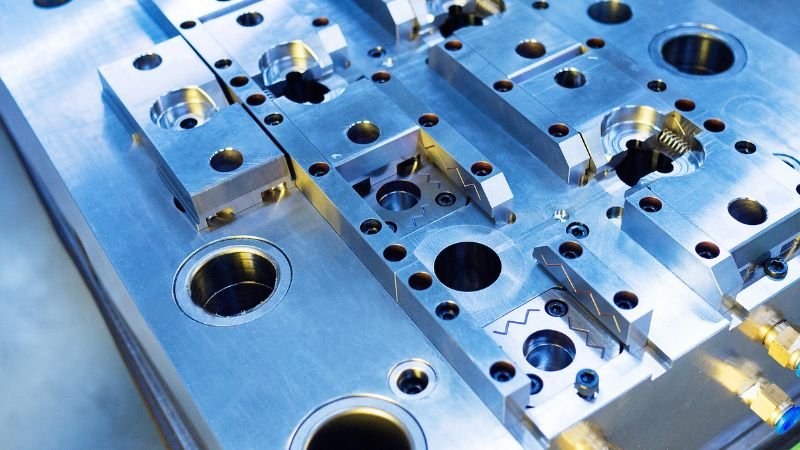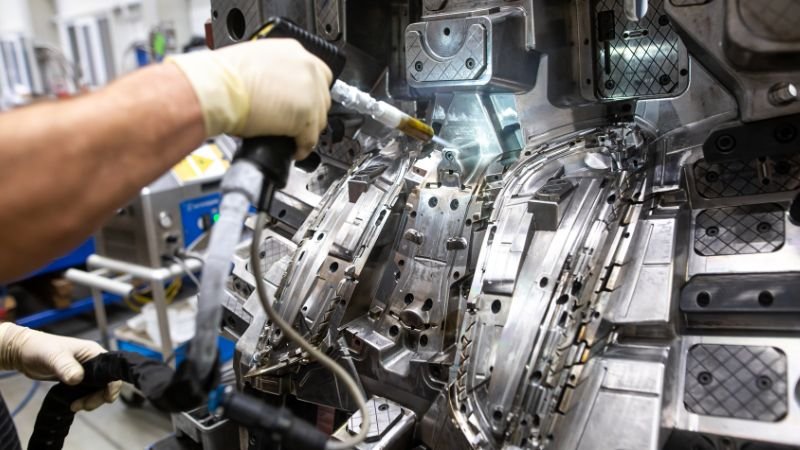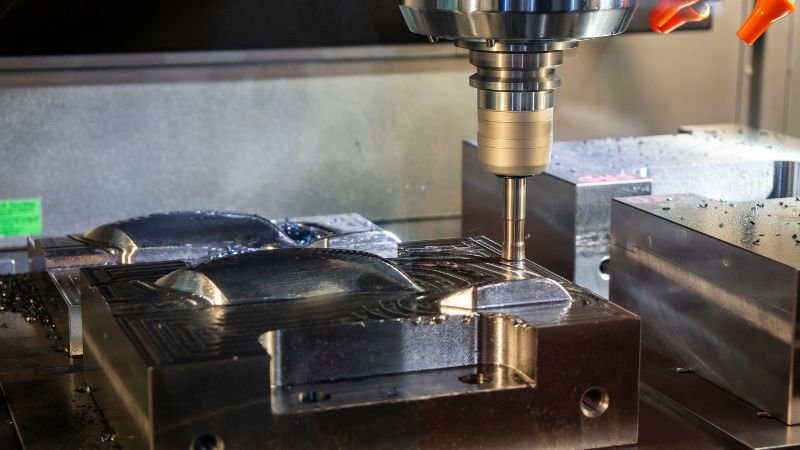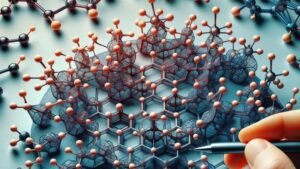Introdución
A fabricación de moldes de inxección de precisión é fundamental para a fabricación, xa que esixe unha mestura de tecnoloxía e artesanía. É vital para produtos pequenos e complexos, onde cada detalle depende dun deseño e fabricación meticulosos de moldes. Os moldes de precisión garanten unha calidade consistente, especialmente nos sectores aeroespacial, médico e electrónico, onde ata pequenos defectos poden provocar problemas significativos.

Que é a fabricación de moldes por inxección de precisión?
A fabricación de moldes por inxección de precisión combina metalurxia, mecánica e unha coidadosa artesanía para crear moldes precisos utilizados para producir compoñentes mediante o moldeado por inxección. A diferenza dos moldes normais centrados na produción en masa, os moldes de precisión priorizan a precisión e a atención aos detalles. Son esenciais para industrias de alto risco onde a precisión é fundamental.
Definición de precisión
A precisión, no contexto da fabricación de moldes, transcende a mera precisión. Encapsula a capacidade do molde para:
- Replicar: Reflicte fielmente o deseño orixinal en cada peza producida.
- Sostén: Manter a exactitude durante numerosos ciclos de produción.
- Consistir en: Asegúrese de que cada peza producida non se distinga das súas pares en dimensión e calidade.
Un marcado contraste coa fabricación de moldes estándar
Comparativamente, os moldes de precisión e os moldes estándar difiren moito nos seguintes ámbitos:
- Tolerancias: Os moldes de precisión cumpren tolerancias moi estreitas, ás veces ata uns poucos micrómetros, o que garante que as pezas producidas sexan perfectamente consistentes e se aliñan coas especificacións do deseño.
- Complexidade: A capacidade de materializar deseños complexos, xeometrías polifacéticas e características complexas é un selo distintivo da fabricación de moldes de precisión.
- Investimento: Tanto en termos de tempo como de recursos, os moldes de precisión requiren un maior investimento, en consonancia coa súa calidade de saída e durabilidade.
Industrias que dependen do moldeado de precisión
Médica, aeroespacial, electrónica e moito máis: numerosos sectores pivotan na destreza dos moldes de precisión:
- Dispositivos médicos: Os moldes de precisión ditan a fiabilidade de innumerables dispositivos médicos, onde incluso unha discrepancia microscópica pode ser prexudicial.
- Compoñentes aeroespaciais: Asegurando que os compoñentes sexan lixeiros pero sen compromisos robustos e precisos, os moldes de precisión xogan un papel fundamental na fabricación aeroespacial.
- Electrónica: A medida que a electrónica se miniaturiza ao tempo que se fai máis complexa, os moldes de precisión permiten a produción de compoñentes compactos, detallados e fiables.

Materiais na fabricación de moldes de precisión
Na fabricación de moldes de inxección de precisión, os materiais son algo máis que a base. Xogan un papel crucial, conectando a precisión do deseño e a durabilidade, garantindo que o molde poida producir constantemente moitas pezas sen perder precisión nin desgastarse.
Características esenciais dos materiais do molde
A selección dun material axeitado para a fabricación de moldes de precisión está entrelazada co recoñecemento e o equilibrio de numerosas propiedades, asegurando que o molde pode:
- Presión de resistencia: Soporta as inmensas presións de inxección sen deformación.
- Resistir o desgaste: Mantén a integridade e o detalle en innumerables ciclos.
- Xestionar a dinámica térmica: Facilitar un arrefriamento eficiente e soportar ciclos térmicos.
Aceiro versus aluminio: unha opción calculada
O aceiro e o aluminio xorden como competidores predominantes nos materiais de moldes, cada un con as súas respectivas vantaxes e limitacións.
Moldes de aceiro
Pros:
- Superior resistencia ao desgaste
- Ciclo de vida extenso
- Excelentes capacidades de acabado superficial
Contras:
- Maior custo inicial
- Tempos de entrega potencialmente máis longos
Moldes de aluminio
Pros:
- Mecanizado máis rápido
- Excelente condutividade térmica
- Menor custo
Contras:
- Ciclo de vida potencialmente limitado
- Posibles problemas de desgaste en escenarios de gran volume
Revestimentos e tratamentos: mellora do rendemento dos moldes
Máis aló das propiedades inherentes do material, os revestimentos e tratamentos serven para amplificar o rendemento do molde, introducindo:
- Resistencia ao desgaste: Aumento da durabilidade do molde fronte a materiais abrasivos.
- Resistencia á corrosión: Protección contra a corrosión potencial de determinados plásticos ou sistemas de refrixeración de moldes.
- Propiedades de lanzamento: Facilitando a expulsión da peza final, minimizando o risco de defectos.
Reciclabilidade e sustentabilidade
Nun mundo que avanza cara a prácticas sostibles, a reciclabilidade e a ecoloxía dos materiais dos moldes creceron en consideracións críticas, que implican:
- Utilización do material: Minimización de residuos durante a fabricación de moldes.
- Reciclaxe ao final da vida útil: Garantir que os moldes se poidan reciclar despois do uso.
- Prácticas ecocompatibles: Empregar prácticas de fabricación que teñan en conta os impactos ambientais.
Técnicas de mecanizado de última xeración
Os moldes de precisión non son só feitos a man, son meticulosamente deseñados, esixindo unha sinfonía de técnicas avanzadas de mecanizado para levar deseños intrincados e precisos á realidade tanxible.
Mecanizado CNC
O mecanizado de control numérico por ordenador (CNC), o eixo principal do moldeado de precisión, automatiza a conversión de deseños dixitais en entidades físicas, garantindo:
- Consistencia: replicación inquebrantable en múltiples ciclos de produción.
- Precisión: respectando as estritas tolerancias intrínsecas á fabricación de moldes de precisión.
- Xestión da complexidade: facilitando a realización de deseños e xeometrías complexos.
Mecanizado de descarga eléctrica (EDM)
O mecanizado de descarga eléctrica (EDM), ou mecanizado con chispa, permite aos fabricantes de moldes tallar funcións detalladas e minuciosas cunha precisión suprema, centrándose en:
- Detalles finos: xerando micro-características e detalles intrincados que doutro xeito serían un desafío mediante o mecanizado convencional.
- Calidade da superficie: ofrece excelentes acabados de superficie, crucial tanto para os aspectos estéticos como funcionais das pezas moldeadas.
- Mecanizado de materiais duros: permite o mecanizado de materiais de moldes endurecidos sen inducir tensión.
Mecanizado de alta velocidade (HSM)
Equilibrando a delicadeza da precisión coa conveniencia da produción, o mecanizado de alta velocidade (HSM) emerxe como un actor clave en:
- Tempos de entrega reducidos: amplificación da velocidade de produción sen comprometer a precisión.
- Acabado de superficie mellorado: minimiza o pulido manual garantindo unha calidade superior da superficie mecanizada.
- Lonxevidade da ferramenta: redución do desgaste das ferramentas de mecanizado debido ás forzas de corte máis baixas.
Mecanizado de 5 eixes
O mecanizado de 5 eixes pivota na súa capacidade de manobrar ao longo de cinco eixes diferentes ao mesmo tempo, desbloqueando:
- Realización de xeometría complexa: capacitar aos fabricantes de moldes para construír formas intrincadas e multidimensionais.
- Accesibilidade da ferramenta: Permite o acceso a funcións de pezas desafiantes e socavacións.
- Mecanizado de configuración única: reducindo os tempos de configuración e os posibles erros facilitando o mecanizado completo nunha única configuración.
Integración de Automatización
A automatización na fabricación de moldes de precisión non é un luxo, senón un requisito, garantindo:
- Produción 24/7: maximizar a produción facilitando ciclos de produción continuos e desatendidos.
- Error humano minimizado: mantendo a coherencia e precisión en todos os moldes producidos.
- Optimización de recursos: Utilización eficiente de materiais e enerxía, aliñando as prácticas de fabricación sostible.

Tolerancias estreitas de enxeñería
Manter tolerancias estritas na fabricación de moldes de inxección de precisión vai máis aló das prácticas típicas de enxeñería, entrando nun ámbito onde cada pequena medida, ata a micra, pode determinar o éxito ou o fracaso.
Definición de tolerancias no moldeado de precisión
No contexto dos moldes de precisión, as tolerancias refírense á variación admisible nos atributos dimensionais da peza fabricada. A definición e o cumprimento destes límites garante que:
- Axuste: os compoñentes intégranse perfectamente nos conxuntos.
- Función: as pezas funcionan de forma óptima sen obstáculos mecánicos.
- Forma: Consérvase a integridade estética e ergonómica.
Técnicas para lograr tolerancias estreitas
- Mecanizado de precisión: Empregando tácticas de mecanizado avanzadas, como mecanizado de 5 eixes e de alta velocidade, que facilitan a consecución e a consistencia de tolerancias estritas.
- Selección óptima de materiais: escollendo materiais que non só resistan un uso rigoroso senón que tamén se manteñen dimensionalmente estables a través de ciclos térmicos e de presión variados.
- Precisión das ferramentas: garantindo que as ferramentas utilizadas para o mecanizado estean meticulosamente elaboradas e mantidas para evitar discrepancias dimensionais na creación de moldes.
Retos no mantemento das tolerancias microscópicas
Garantir e manter tolerancias nuns poucos micrómetros presenta unha serie de desafíos:
- Comportamento do material: xestionar os matices de como os materiais se expanden, contraen e se deforman en condicións de operación diversas.
- Estabilidade de mecanizado: mantendo unha estabilidade e precisión infalibles en ciclos de mecanizado extensos e repetidos.
- Desgaste: contrarrestar o impacto sutil, aínda que acumulativamente significativo, do desgaste nas ferramentas e os moldes.

Control de calidade & Inspección
No complexo ámbito da fabricación de moldes de inxección de precisión, é fundamental asegurarse de que cada molde cumpra especificacións e estándares de calidade especificados.
O imperativo de precisión
- Tolerancias microscópicas: comprender e xestionar os retos de manter a precisión dentro das tolerancias microscópicas.
- Impacto directo sobre os produtos finais: entender como a precisión dos moldes se traduce directamente na calidade e funcionalidade dos artigos fabricados.
Protocolos de control de calidade
- Verificación do deseño: asegúrese de que o deseño do molde é robusto e se adhire á aplicabilidade tanto teórica como práctica.
- Verificación de materiais: confirmación de que os materiais utilizados na fabricación de moldes cumpren as normas estipuladas e son axeitados para as aplicacións previstas.
- Verificación do proceso: supervisión continua do proceso de elaboración de moldes para garantir o cumprimento dos protocolos e puntos de referencia predeterminados.
Técnicas e Tecnoloxías de Inspección
- Inspección visual: implantación de técnicos cualificados para realizar inspeccións visuais detalladas en varias fases do proceso de elaboración de moldes.
- Axudas tecnolóxicas: implementación de tecnoloxías como a inspección asistida por ordenador (CAI) e as máquinas de medición por coordenadas (CMM) para mellorar a precisión da inspección.
- Probas non destrutivas (NDT): Empregando técnicas como probas de ultrasóns e probas de raios X para inspeccionar moldes sen causar ningún dano ou alteración.
Abordar e subsanar deficiencias
- Protocolos de corrección: Implantación de procedementos normalizados para abordar e corrixir as deficiencias identificadas durante as inspeccións.
- Análise da causa raíz: implantación de metodoloxías para identificar e abordar as causas raíz dos problemas, evitando a súa repetición.
- Mellora continua: implicarse nun proceso continuo de retroalimentación, corrección e mellora para mellorar a calidade e a eficiencia xeral.
Documentación e Conformidade
- Documentación de calidade: documentar meticulosamente os procesos de control e inspección de calidade, achados e accións correctoras.
- Verificación de conformidade: Asegurar que todos os procesos de control e inspección de calidade cumpran coas normas locais, nacionais e internacionais pertinentes.
- Preparación para auditorías: Manter a preparación para auditorías internas e externas para validar a eficacia e o cumprimento dos procesos de control de calidade.

Análise do fluxo de moldes & Optimización do deseño
A exploración dos aspectos técnicos da creación de moldes, a análise do fluxo de moldes e a optimización do deseño xorden como etapas críticas. É esencial garantir que o material fundido flúe de forma óptima a través do molde e que o deseño se refire tanto para a eficiencia como para a calidade.
Fundamentos da análise do fluxo de moldes
- Propósito e importancia: descubrir por que a análise do fluxo de moldes é fundamental para anticipar os posibles retos de fabricación.
- Tecnoloxías de simulación: Empregar ferramentas de simulación avanzadas para visualizar o fluxo de material, identificar problemas potenciais e formular solucións.
- Análise de datos: análise de datos de simulacións para comprender a intrincada dinámica do fluxo de material dentro do molde.
Identificación de desafíos relacionados co fluxo
- Liñas de soldadura e trampas de aire: detección de áreas propensas a formar liñas de soldadura e trampas de aire que poden comprometer a integridade do produto.
- Esfuerzo cortante: análise de rexións de alto esforzo cortante que poden afectar as propiedades do material e a calidade do produto.
- Incoherencias de refrixeración: identificación de posibles inconsistencias no arrefriamento que poden provocar deformacións e problemas de calidade.
Estratexias de optimización do deseño
- Deseño iterativo: adoptando un enfoque iterativo, perfeccionando continuamente o deseño do molde baseado nos coñecementos da análise de fluxo.
- Equilibrar a estética e a funcionalidade: lograr un delicado equilibrio entre manter o atractivo estético e garantir a fiabilidade funcional do produto final.
- Eficiencia do material: optimización do deseño para garantir un uso mínimo de material preservando a calidade e a funcionalidade do produto.
Selección do material e o seu impacto no fluxo
- Características do material: comprender como as diferentes propiedades dos materiais (como a viscosidade, a condutividade térmica, etc.) inflúen no fluxo dentro do molde.
- Sincronización material-deseño: garantindo que o deseño do molde está adaptado para acomodar e optimizar as características do material elixido.
Integración de comentarios para a mellora continua
- Utilizando datos do mundo real: incorporando coñecementos e datos derivados de producións reais para perfeccionar aínda máis os deseños de moldes.
- Modelos de deseño adaptativo: empregando modelos adaptativos que se poden modificar e optimizar segundo os requisitos e os avances tecnolóxicos en evolución.
- Aprendizaxes entre proxectos: aplicando as aprendizaxes e os coñecementos dun proxecto para anticipar e afrontar os desafíos en futuros esforzos.

Tecnoloxías Avanzadas e Perspectivas de Futuro
A viaxe da fabricación de moldes de precisión está en continua evolución, conformada pola onda de avances tecnolóxicos e perspectivas innovadoras que están a dar forma ao futuro da fabricación.
Incorporación da intelixencia artificial (IA)
A intelixencia artificial está infiltrando constantemente nos reinos da fabricación de moldes mediante:
- Mantemento preditivo: utilizando a IA para anticipar e abordar de forma preventiva as necesidades de mantemento de máquinas e moldes, minimizando os tempos de inactividade non planificados e garantindo unha precisión sostida.
- Garantía de calidade: Empregando algoritmos intelixentes para examinar e garantir o cumprimento da calidade durante todo o proceso de elaboración de moldes.
- Optimización de procesos: análise de datos en tempo real para optimizar dinámicamente o proceso de fabricación, mellorando a eficiencia e a calidade da saída.
Fabricación aditiva (impresión 3D)
A fabricación aditiva, ou impresión 3D, é pioneira en novos horizontes:
- Prototipado rápido: Acelerar as fases de deseño e proba de moldes mediante a creación rápida e rendible de prototipos.
- Personalización: facultar aos fabricantes para producir moldes personalizados de forma rendible para producións de curta duración ou aplicacións a medida.
- Fabricación de xeometría complexa: permite a produción de moldes con xeometrías complexas que son difíciles ou imposibles de producir mediante métodos tradicionais.
Incorporación de Internet das Cousas (IoT)
A Internet das Cousas (IoT) entrelaza os ámbitos físico e dixital, introducindo:
- Monitorización remota: facilitando o seguimento en tempo real do proceso de elaboración de moldes desde calquera lugar, garantindo unha supervisión continua e unha pronta intervención cando sexa necesario.
- Decisións baseadas en datos: aproveitar o poder dos datos interconectados para tomar decisións fundamentadas que melloren a eficiencia
, calidade e sustentabilidade.
- Análise preditiva: aproveitando os datos de IoT para prever e previr problemas potenciais, fomentando un enfoque proactivo para a fabricación de moldes.
Prácticas verdes e sostibles
Un enfoque cada vez maior na sustentabilidade ambiental marca prácticas que abarcan:
- Materiais ecolóxicos: exploración e adopción de materiais de molde que sexan biodegradables ou feitos de fontes recicladas.
- Eficiencia enerxética: implantación de procesos e equipamentos de fabricación eficientes enerxéticamente.
- Redución de residuos: minimiza a xeración de residuos durante a fabricación de moldes e a reciclaxe de moldes ao final da súa vida útil.
Conclusión
A fabricación de moldes de inxección de precisión é a fusión artística de detalle meticuloso e precisión científica, impulsando a innovación en industrias como a saúde, a aeroespacial, a electrónica e a automoción. Funciona tranquilamente entre bastidores, configurando a nosa vida diaria. De cara ao futuro, evolucionará aínda máis, aproveitando a IA, a impresión 3D, o IoT e a sustentabilidade para redefinir as posibilidades. A precisión non é só un estándar, é unha barra en constante aumento e a calidade é inquebrantable. A fabricación de moldes de inxección de precisión encarna o enxeño humano, destacando nun mundo onde ata os máis pequenos detalles teñen o poder da grandeza.





